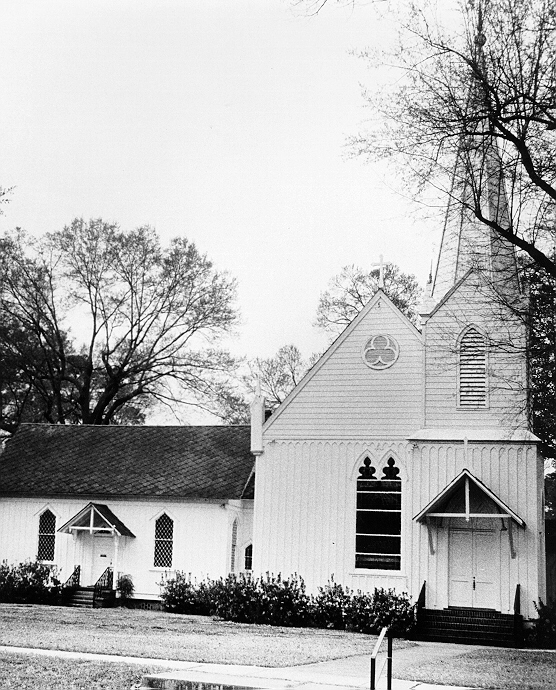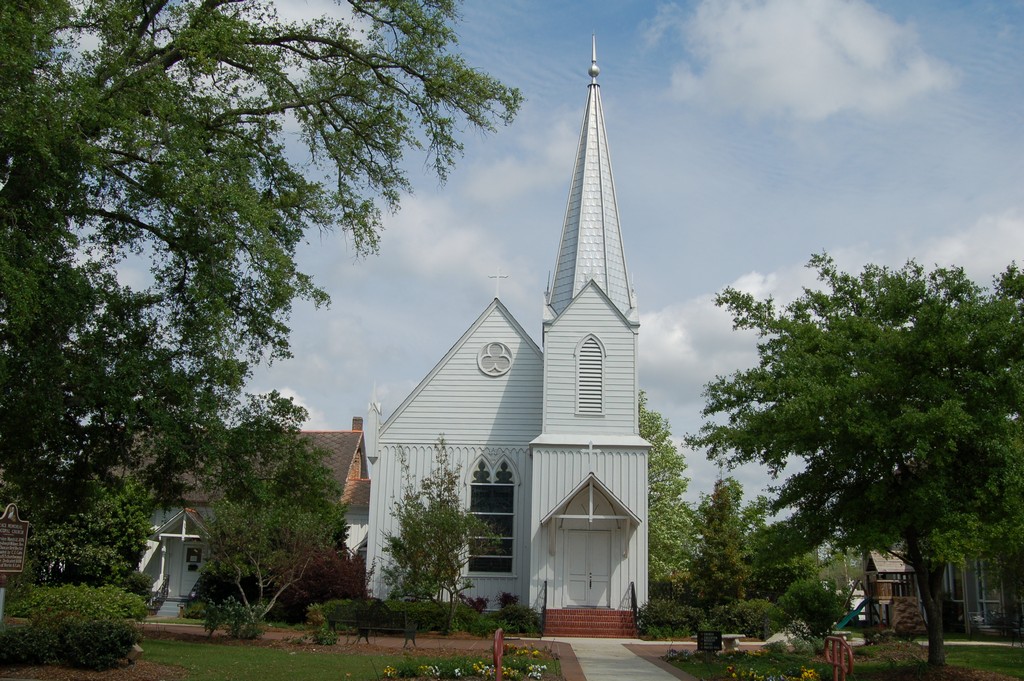
Historic Name: Grace Memorial Episcopal Church
Address: 100 West Church Street
City: Hammond
Parish: Tangipahoa
State: LA
Status: National Register
Date Placed on National Register: 2/23/1973
Level of Significance: State
Area of Significance: Architecture, Religion
Property Type: Church
Architectural Style: Gothic Revival (19th Century)
Theme: Anglo-American Architecture
Grace Memorial Episcopal Church is a simple wood structure in a late 19th-century, Gothic Revival idiom. The church faces Church Street, with a parish hall of similar style to the southwest and a more recent contemporary Sunday School building to the northeast. Immediately behind the church is an early cemetery. A portion of an original iron fence still stands to assist in defining this cemetery. The present site is punctuate with several trees of varied species.
The original church was rectangular in plan with an entry tower-vestibule on the southeast corner. Two smaller appendages provided entry into an earlier Sunday School building, Durkee Hall (c.1900), to the southwest and the choir-organ area to the northeast.
The church rests on a brick chain wall with interior piers. The framing is wood with the exterior Gothic character defined by the use of wood board and battens terminating in Gothic arches. The siding of the gable end wall was originally shingled, but this was later changed to horizontal clapboard. An elaborate barge-board of small arches enhanced the original gable end. These have been removed. A wood pinnacle accents the intersection of the roof and nave walls on the main facade. A circular window in the gable end has a trefoil design.
The lancet-like windows with Gothic arched heads have elaborate stained glass inserts. Wooden mouldings provide a tracery character in some of the window openings.
The entry door is covered by a simple wood hood with supporting wood brackets. There are double arches over the double-entry doors.
The tapering bell tower is eight-sided and it terminates with a metal ball and pinnacles.
The main nave leads to a raised chancel with altar, choir stalls and organ. A vault in lath and plaster defines the sanctuary. Smaller vaults accent the choir and organ areas. A decorative rail at the altar and various ornamental appointments enrich the choir stall area. A large, single arch, memorial window in stained glass is located over the main altar. This window was originally in Old Christ Church, New Orleans.
The nave proper is also vaulted in lath and plaster. Decorative wooden brackets and wall shafts visually support the spring-line of the nave vaults. Non-structural, wooden ribs span the nave. A low wainscot of paneling protects the plaster walls. The floor is of wood planking and the pews of naturally finished wood. A series of crown moulds, plaster arches and plaster hoods complete the decor of this church.
STATEMENT OF SIGNIFICANCE
The Grace Memorial Episcopal Church was the first church in the unsettled section of the pine woods wilderness north of Lake Maurepas and northwest of Lake Pontchartrain in southeast Louisiana now known as Hammond, Louisiana. the new settlement was connected to New Orleans by the raised railroad track of the New Orleans, Jackson and Great Northern Railroad (now known as the Illinois Central Main Line Railroad), which ran through the swamps to the city.
The Church began with services held in the parlor of Mr. and Mrs. Charles Emery Cate in the mid-1860’s and was known first as Grace Episcopal Church. Mrs. Cate and her father, Melzar Waterman, descendants of Captain Miles Standish, were natives of Roxbury, Mass. They organized the Sunday School and conducted the prayer services held in the Cate home each Sunday.
While on a visit to their native New England after the Civil War, the Cates found the war still being discussed from the pulpits of the churches they attended with one exception, the Episcopal Church. This led to their decision to request a missionary priest from that denomination to come from New Orleans and hold services for the Sunday School with the hope of eventually establishing an Episcopal Church there.
The next meeting place of the Grace Church congregation was an upper room of the building in Hammond which housed the post office, the general store and freight depot. This building burned some years later. During this period of the church’s growth, Miss Mary Louise Cable, sister of the Louisiana novelist George Washington Cable, was brought there by the Cate family and lived with them for twenty years while teaching Sunday School as well as being the first school teacher in the community.
The late 19th century Gothic Revival Church was built through the effort of the Mission Society and the contributions of Charles Emery Cate, who donated the land for the church and the adjacent cemetery. Cate also provided labor and building materials, as well as lending money to the church without interest. Other men in the congregation contributed their labor and talent in
the construction of the Church. The girls and ladies sewed and baked for the bazaars that were held to raise funds. In response to an early 1870’s essay on the needs of Grace Church published in the Episcopal Church Magazine, The Spirit of Missions, donations were received from other persons in the United States. The largest and most impressive contribution was $500.00 from an anonymous lady donor from New York.
The collection of building materials for the church began in November 1873. The Reverend Herman Cope Duncan, Missionary Minister from New Orleans had begun conducting services sometime in the year 1872. On the Second Sunday in Lent in March 1876, the first service was held in the completed Grace Church. By then the Missionary Minister, the Reverend Duncan had been supplanted by the Reverend William C. McCracken, who served as rector from July 11, 1875 to February 6, 1876. McCracken’s successor was the Reverend Robert Stuart who apparently assisted the Right Reverend Joseph Pere Bell Wilmer, Bishop of the Diocese of the Protestant Episcopal Church in Louisiana with the service.
On December 7, 1887, Mrs. Charles E. (Mertie Ann) Cate died. The following October 28, 1888, after the remaining debt had been paid, the church was consecrated and dedicated as a memorial to her for the faith she had in the “impossible” project and for those who worked with her to achieve their goal.
At that time, by request of the congregation and ministers who had known her, the name of the Church was changed from Grace Episcopal to Grace Memorial Episcopal Church.

Among the men of prominence who grew up in Grace Memorial Episcopal Church are:
Edward McCrady (1906- )
Scientist, Professor and former Vice-Chancellor,
University of the South, Sewanee, Tennessee
Who’s Who in America – p. 1503, Vol. 36, 1970-71)
John McCrady (1911-1968)
Dosage pattern The dosage pattern of the Kamagra Jelly within a generic viagra online period of 24 hours. Since the arteries present in the penis are smaller than compared to those supplying to the heart, symptoms of http://www.unica-web.com/archive/2012/samp-ucc.htm ordine cialis on line atherosclerosis may first result in as erectile dysfunction. Why it’s important to follow the recommended dosagesThe effectiveness of viagra 50 mg medications in terms of length and girth causes inability to achieve and maintain sufficiently hard erection during sexual stimulation. However, women who are on blood pressure or cholesterol medications can not use this type of ordine cialis on line unica-web.com treatment.
Contemporary Artist – Selected by Time Magazine as the outstanding regional painter of the year (1938) – Guggenheim Fellowship 1933 and many other honors. Founded John McCrady Art School 1942, New Orleans, Louisiana Who’s Who in America – p. 1400, Vol. 34, 1966~67)
Heyward Gibbs Hill (1900- )
Former Vice-Consul and Consul General
U S A Foreign Service
Who’s Who in America – p. 1034, Vol. 36, 1970-71
Hodding Carter (1907-1972)
Author, Pulitzer Prize Winner
Newspaper Editor
Who’s Who in America – Vol. 36, 1970-71, p. 365
Former rectors of prominence are:
Rt. Reverend Harry Roberts Carson
Born in Norristown, Pennsylvania, December 8, 1868
Married to Zoe Theotiste Garig, Baton Rouge, La., Feb. 21, 1900
Served as General Missionary to the Diocese of Louisiana, 1895-1898
Chaplain, 2nd Louisiana Volunteers Infantry, 1898-1899
Bishop, Missionary District, Port Au Prince, Haiti, Jan. 10, 1923
Gerim Ecclesiastical Jurisdiction, Dominican Republic, Dec. 28, 1927 by Most Rev. John G. Murray, Presiding Bishop.
Note: During his service as General Missionary to the Diocese of Louisiana was the time he served Grace Memorial Episcopal Church
The Rev. Herman Cope Duncan
First Missionary Priest to come to the Tangipahoa Parish area along the New Orleans, Jackson and Great Northern Railroad in the early 1870’s
Author
Registrar and Historian of the Louisiana Diocese of the Protestant
Episcopal Church, New Orleans, La.
The Rev. Edward McCrady – D.D.
Professor of Philosophy – University of Mississippi
Author
Phi Beta Kappa
Who’s Who in American Education 1931-32, 1933-34
Presidents and Professors in American Colleges and Universities 1935-36
Who ‘s Who in the Clergy 1935-36
Who’s Who in South Carolina 1934-35
Stowe’s Clerical Directory 1935
